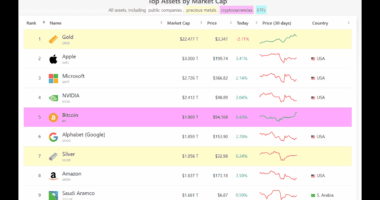Bitcoin’s volatility has dropped below that of the S&P 500 and Nasdaq for the first time in a rare and noteworthy shift, according to analysts at Galaxy Digital. This change comes amid growing institutional demand for BTC, further signaling the asset’s maturation.
In April, Bitcoin not only delivered double-digit gains but also posted lower realized volatility than two of the most closely watched U.S. equity indexes — a surprising feat for an asset long associated with sharp price swings.
Galaxy reports that Bitcoin’s 10-day realized volatility fell to 43.86, dipping below the S&P 500’s 47.29 and the Nasdaq 100’s 51.26. This, they note, represents an “unusual positioning for a digital asset traditionally known for its outsized volatility.
A shift amid traditional market turbulence
The shift comes as traditional markets experience renewed instability. Following former President Donald Trump’s “Liberation Day” tariff declaration on April 2, equity markets have faltered. The Nasdaq Composite has remained flat, the Bloomberg Dollar Index has dropped nearly 4%, and even gold — typically a safe-haven asset — briefly surged to $3,500 per ounce before settling at a 5.75% gain.
In contrast, Bitcoin has rallied 11% over the same period, reinforcing its evolving role as a macroeconomic hedge amid geopolitical and fiscal uncertainty.
Correlation weakens, investor perception evolves
Despite maintaining a 30-day correlation of around 0.62 with the S&P 500 and 0.64 with the Nasdaq, Bitcoin’s beta has declined — a signal that the market may be reclassifying the asset. Chris Rhine, head of liquid active strategies at Galaxy, emphasized Bitcoin’s unique position: Bitcoin as a non-sovereign asset means an investor doesn’t need the full faith or tax basis of a nation to support the integrity of the asset.
Galaxy analysts compared the current investor behavior to patterns seen during the 2018–2019 U.S.-China trade war, when Bitcoin also gained as global uncertainty rose.
Bitcoin becoming digital gold
According to Hank Huang, CEO of Kronos Research, a wave of ETF inflows and persistent strategic purchases are contributing to a structural shift in Bitcoin’s market role. As institutions deepen liquidity, volatility drops, making Bitcoin a cornerstone for portfolios.
Galaxy’s OTC desk describes the current market tone as tactically cautious but structurally constructive, underpinned by prudent leverage and minimal hedging pressure.
With 95% of Bitcoin’s total supply already mined and demand rising from institutions, ETFs, and even governments, the case for Bitcoin as a digital store of value is growing stronger.
Ian Kolman, co-portfolio manager at Galaxy, said the asset’s supply-demand profile is reinforcing its status as a mature store of value in the digital era.
Adding to this narrative, BlackRock’s head of thematics and active ETFs, Jay Jacobs, noted on April 25 that geopolitical fragmentation is driving countries away from dollar-based reserves and toward uncorrelated assets like gold — and increasingly, Bitcoin. Bitcoin is now viewed alongside gold as a safe-haven asset, Jacobs said, highlighting a paradigm shift in global asset allocation.




